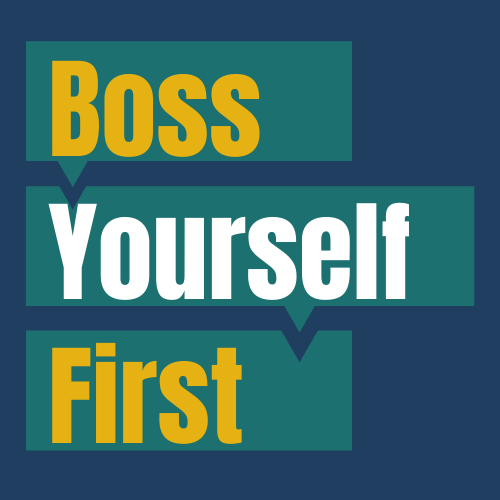The Freedom of Constraint
Today we’re introducing our topic for Season 2. This season we’re exploring constraint. While freedom and constraint may seem like opposing forces, we’re going to spend the next couple of months exploring the way self-leaders can leverage constraint to increase creativity and innovation. We’ll learn to use the power of constraint to free up and even accelerate forward movement. Today we define constraint, introduce this season’s book club read and challenge ourselves to start playing with the power of constraint. Join us, it’s going to be a great season and we’re just getting started!
Episode Transcript
Welcome to season two of the Boss Yourself First podcast! I hope you had an amazing holiday season. I know it was probably different, I know it was for us but we got creative about how to connect with family and still take precautions to protect everyone from Covid. And that creativity to work around limits leads me right into this season’s topic. This season we are talking about constraint and how self-leaders can leverage constraint to move forward. As I just mentioned, most of us encountered or imposed constraints on our holiday celebrations so it feels like a timely pursuit. I’m so excited to jump into this season’s topic! I have a long history with constraint and I find the mindset and the process of leveraging constraint really freeing. Which sounds a little paradoxical – constraint and freedom but I think they are a powerful pairing. My constraints have generally come as physiological conditions. But I have had three major constraints I mean I have some of the normal ones of finance and busyness, but the health constraints felt the most impactful. In fact, the first one showed up in my early 20’s the next in my 40’s and the most recent one in 2019. I’ll unpack these a bit more later in the season but I can track my self-leadership skill development by my exposure to these constraints and how deftly I processed constraints to leverage them for forward movement. Also, my relationship with constraint has really informed my client work in ways that my training and certifications never could. And I hope to bring the forward here this season as we explore and learn about constraints together.
As we do for each topic we explore, I want to get really clear on how we’re defining constraint. So Today we’re going to unpack our definition of constraint, explore why it is helpful and then share a challenge with you at the end of the episode. The first definition I found when I began to prepare for this is a limitation imposed by outside circumstances or by ourselves that materially affects our ability to do something. Well circle back to that definition soon,
But before we do, I want to tell you a couple of stories that can help focus our ideas about constraint.
I want to take you back to 1930 in Uruguay where a young teacher named Juan Carlos Ceriani devised a game similar to soccer but that could be played inside for his students. He named the game “futsal” The most noticeable difference between futsal and soccer is the size of the field. Futsal happens in a much smaller space. Ceriani’s game caught on and in the 30’s and 40’s became really popular in Brazil. Interestingly, today more people in Brazil play futsal than soccer and there are a number of speculations about why this is. A dominate one is that because of space limitations, futsal is easier to accommodate in Brazil but there was an intriguing side effect of Brazil’s love affair with futsal. Because many Brazilian children start playing futsal and later transition to soccer they develop extraordinary agility in ball handling along with quick reflexes and game decision making skills. The smaller playing area of futsal requires the athletes to speed up in their reactions, decision and movements. Check this out, during the 12-year span from 1958 to 1970, Brazil won three of the four World Cup Championships. The constraint of futsal brought innovation to the athletic training of Brazilian Soccer players.
You may already be familiar with the next story but a writer was challenged by his publisher, to create a children’s book limiting himself to 225 words chosen for him from 6-7 year-olds vocabulary lists. His goal was to make something more interesting and challenging than the current Dick and Jane books used in education at that time. The writer grew frustrated with this list and gave himself a further constraint. He would choose the first two words on the list that rhymed for the foundation of his story. Those two words? Cat and Hat. Yes, the writer was Theodor Geisel also known as Dr. Seuss. He leveraged constraint to focus his creativity. If that wasn’t enough, Geisel’s publisher then challenged him to create a children’s book using 50 words –they bet $50 and Geisel once again gave himself another constraint and utilized 49 one syllable words and 1 three syllable word at the end – 9 months later, (no one said it was quick or easy leveraging constraint) Geisel presented his publisher with what became Green Eggs and Ham.
So constraint! Now you know that I choose a book to go along with our season and I’m not choosing Dr. Seuss but that’s always a fun read, so maybe we’ll have to add it in. If you want to read with our group you can join the BYF Face Book group where I will post a reading schedule and we will discuss what we’ve read during the season. This season’s book is A Beautiful Constraint, by Adam Morgen and Mark Barden. And you’ll hear me refer to it throughout our season but one reason I chose it, is I really appreciate it’s approach to constraint is the recognition of the cycle we work through when dealing with constraint. Which we will jump into in episode two. Right now, I want to bring us back to our definition of constraint which is is a limitation imposed by outside circumstances or by ourselves that materially affects our ability to do something. Now Morgen and Barden want to amend that definition just a bit they would like to define constraint as “’A limitation or defining parameter, often the stimulus to find a better way of doing something.”
I like this focus on the effects of constraint so for our season we’ll be defining constraint as a limitation or defining parameter imposed by outside circumstances or by ourselves that can stimulate creativity and innovation.
As our definition states, there are two kinds of constraints external – limitations imposed by outside forces or circumstances – like the weather Ceriani encountered motivating him to design inside activity for his students, or the space restrictions that motivated Brazilians to embrace the smaller, inside game. The other kind of constraint is internal – a limitation you impose on yourself to focus and inspire your thoughts like Geisel did with choosing the first two rhyming words and then later limiting himself to one syllable words. I find it really interesting that most external constraints have a negative connotation while most internal constraints have a negative connotation. I’m sure you’ve already noticed what might be contributing to that difference. Choice. We feel empowered by choice and disempowered by the lack of it and who wants to feel disempowered? There are so many different facets to explore and variety of skills we can develop around constraint. I hope you feel empowered and use that power to choose to tune in for our whole second season. The best way to ensure you don’t miss an episode is to subscribe where ever you listen to podcasts and I would be so grateful if you would take the time to leave a review. It helps others find the podcast and it really encourages me. On our next episode, we’re talking about the cycle of processing constraint and the self- leadership principles to move through that process. Now before you go, I want to give you a challenge that I gave myself so we can start playing with choosing constraint. And there is a bit of a story behind the challenge. And it is really a myth, the origins of the story are questionable but it sets up our challenge well. Once again we’re traveling back in time this time to the 1920’s to a crowded restaurant at the Algonquin Hotel in New York City where Ernest Hemingway made a $10 dollar bet with some other writers that he could write a six-word short story. After composing the story on to a napkin, he passed it around the table and collected his winnings. His story read, “For sale, Baby Shoes, Never Worn.” My love for this story is not really diminished by it’s debatable veracity. The constraint of those 6 words allows Every reader to bring their own context to the story. So my challenge for you is to answer two questions using only 6 words in each answer. The questions are: How would you describe 2020? How do you hope to describe 2021? I’m no Hemingway but here are mine. In answering How I describe 2020 in 6 words I wrote “And the whole planet stayed home.” In how I hope to describe 2021. Gratefully, I left my mask behind. I hope you accept the challenge and I would love to hear your answers. You can email them to me at robyn@bossyourselffirst.com or post them on the Boss Yourself First Facebook Page or comment on a boss yourself first post on Instagram. C’mon take the challenge! And until next time, take care!

